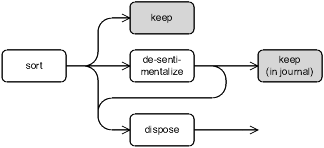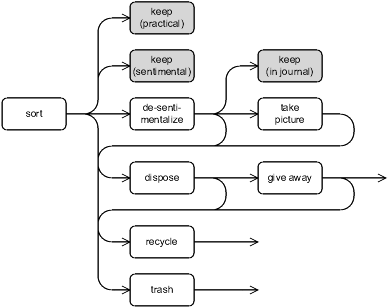Home
> urticator.net
Search
About This Site
Domains
> Glue
Stories
Art
Memes
The Mind
The Body
Language
Philosophy
Strategies
Other
> Other (2)
Don't Fight Your Mind
Superorganisms
Beauty
Thoughts About Email
> How I Cleaned My Room
Household Memes
Separation of Functions
Multiple Passes
De-Sentimentalization (1)
Disposing of Things
|
> De-Sentimentalization (2) |
De-Sentimentalization (2)
Here I want to talk about de-sentimentalization of multiple objects with various sentimental values. Single objects are covered in De-Sentimentalization (1).Suppose I'm good at the single-object form of de-sentimentalization: given an object, I can describe the heck out of it, maybe take a picture, no problem. And, suppose I have a box of old stuff that I want to de-sentimentalize. What do you think I do? Do I go through and robotically describe every single object? Of course not! I go through and look at the objects and decide what to do with them. Some have lots of sentimental value, so I keep them; some have hardly any sentimental value, so I dispose of them; it's only the ones in between, with moderate sentimental value, that I want to de-sentimentalize. That one little idea is the center of this essay, but there are still plenty of details and ramifications to talk about.
The largest detail is that for me, stopping to de-sentimentalize breaks the flow of deciding what to do with the objects, so the whole process works a lot better if I use multiple passes. So, what I really do is, I sit down on the floor, grab a pile of stuff from the box, and start sorting it into three smaller piles, one to keep, one to de-sentimentalize, and one to dispose of. Then, whenever I have a satisfactory amount of stuff to de-sentimentalize, I stop and do that. Here's a flowchart of the process, including what happens to the objects after they're de-sentimentalized. I shaded the final states just to make them look nicer.
There are four smaller details that I'd like to add to that flowchart.
- Usually when I keep something it's because it has sentimental value, but once in a while I'll find something in a box of old stuff that actually has some use, some practical or other non-sentimental function. When I keep something like that, I don't just pack it away in another box somewhere, I make it an integral part of my household. So, there are two different ways to keep things.
Another way to see the difference is to think of the things I keep for sentimental reasons as just an extension of the senti-journal.
- Taking good pictures requires getting up, moving around, and arranging things, and thus generally breaks the flow of de-sentimentalization; so once again multiple passes are needed. So, as I de-sentimentalize, I make a pile of things to take pictures of. Then, whenever it gets large enough—usually after several de-sentimentalization passes—I stop and do that.
- The virtue of the idea of disposing of things is that it conceals a whole process—I can make the decision to dispose of something without having to spend any effort getting into the question of how. But, sometimes it's obvious that a thing should just go into the recycle bin or the trash, and then there's no sense in waiting 'til later to do it.
- When I do finally get around to disposing, I can usually think of some way to give away or sell most of the things, but there are always a few that wind up in the recycle bin or the trash after all. It wasn't obvious they'd have to go there, that's just what the result happened to be. It also occasionally happens that I'll imagine something has value, try to give it away or sell it, and fail. Those unfortunate creatures also wind up in the trash.
Here's an improved flowchart that includes all of those details.
There are four even smaller details that are too complicated to add to the flowchart.
- I swept something under the rug just a second ago. First I stated that disposing of things is a whole process, then I made it sound like it's just a matter of sorting things into three categories. So where'd the process go? It's still there, just shifted to the “give away” box. If I'm trying to give something away, then among other things I might have to ask several friends before I find one who wants it, hold on to it until the next time I see ver, or maybe wait and see whether I can sell it online.
- A side benefit of using multiple passes is that it provides a bit of look-ahead—when there are several objects that belong together, I'll often see and be aware of all of them before I start de-sentimentalizing the first one. As a result, I can group them and describe them more effectively. Conversely, sometimes I'll see one object, remember there are others that belong with it, and then not find them all even with a reasonable look-ahead. When that happens, I might (or might not) decide to create a temporary pile to hold the objects until I locate the complete set. On a few of the occasions when I did that, the objects turned out to be so scattered that the temporary piles became nearly permanent; in fact I ended up moving them into file folders.
- Once in a while I'll create a temporary pile for some other reason, for example to hold papers that I'm planning to make photocopies of (in order to separate the functions). The pile of things to take pictures of is really just another example of that behavior.
- When other people are involved, the process becomes even more complicated. For example, among the many objects in my old room were a few that my parents had allowed me to keep but that still belonged to them, like my mom's slide rule and my dad's collection of science fiction stories from the '50s and '60s. The objects had acquired some sentimental value for me, so I had to decide whether I wanted to keep, de-sentimentalize, or dispose of them, but then I also had to check whether my parents wanted to keep or dispose of them. And what was the right order of events? In the end, what I did was create three “review” piles parallel in meaning to the original three piles, sort the objects accordingly, de-sentimentalize whatever I wanted to de-sentimentalize (which eliminated one of the three piles), then let my parents review the contents of the other two. They kept whatever they wanted, then I kept the remaining objects in the first pile and disposed of the remaining objects in the second.
Now we come to the tiniest detail, which is that sometimes I cheat. Even after the initial sorting step I'll still sometimes decide to keep one thing or another—maybe a thing that revealed unexpected qualities during de-sentimentalization, maybe the prettiest of the things I'm taking pictures of, or maybe the most pitiful of all the things in the trash. But, take a look at the words I used there: “the prettiest”, “the most pitiful”. What I'm really doing when I cheat is applying the principle of selection!
The principle of selection is active at other times too: when I choose what to keep and what to de-sentimentalize, when I identify the important parts of an object and then draw them or cut them out. And, since the selection is on the basis of sentimental value, of course the output of the whole process (the senti-journal plus the saved objects) has way more sentimental value per unit volume or whatever (sentimental value density!) than the raw input. In other words, it's a refined product, the cocaine of sentimental value; see also Liking What You See. That's somewhat unfortunate if your goal is to free yourself of sentimental attachments, but if you just want to reduce the amount of stuff you have, I'd say it's a pretty good little process.
See Also
De-Sentimentalization (1)
How I Cleaned My Room
@ August (2010)

